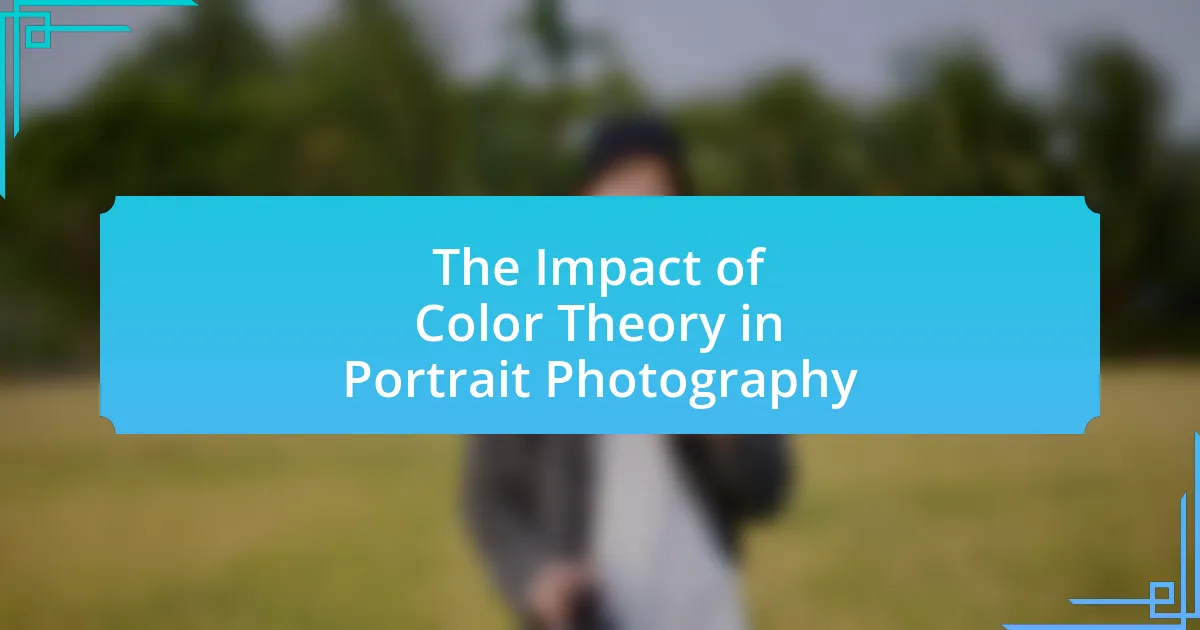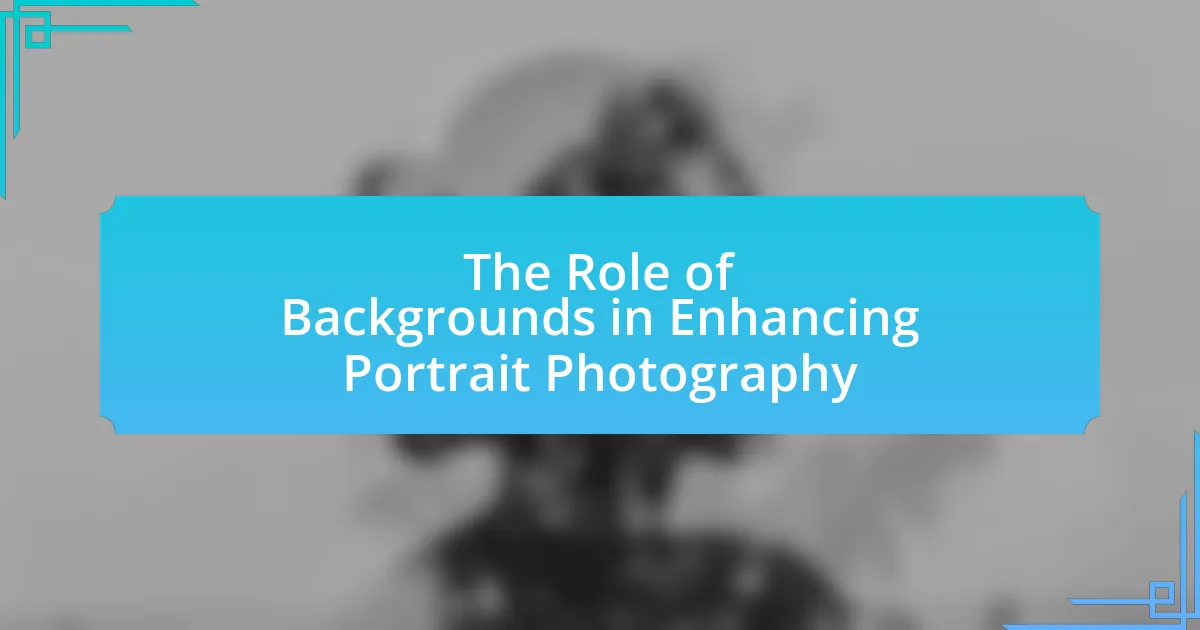The article focuses on effective techniques for posing subjects in portrait photography to enhance visual impact and emotional resonance. Key elements discussed include body positioning, facial expressions, and the use of space, all of which contribute to creating engaging portraits. The article also explores the influence of body language, posture, and environmental factors on the overall composition, as well as best practices for eliciting genuine expressions from subjects. Additionally, it highlights common mistakes to avoid and advanced techniques that can elevate portrait posing, ensuring that photographers can capture authentic and compelling images.

What are the key elements of posing subjects in portraits?
The key elements of posing subjects in portraits include body positioning, facial expression, and the use of space. Body positioning involves angling the subject to create depth and interest, such as turning the shoulders slightly or placing one foot forward. Facial expression is crucial for conveying emotion and connection; a genuine smile or thoughtful gaze can significantly enhance the portrait’s impact. The use of space refers to how the subject is framed within the composition, ensuring that there is balance and that the background complements rather than distracts from the subject. These elements are supported by principles of visual aesthetics, which emphasize the importance of alignment and emotional resonance in effective portrait photography.
How does body language influence portrait photography?
Body language significantly influences portrait photography by conveying emotions and personality traits that enhance the subject’s presence. When subjects adopt open postures, such as relaxed shoulders and facing the camera, they project confidence and approachability, which can lead to more engaging portraits. Research indicates that nonverbal cues, including gestures and facial expressions, account for a substantial portion of communication, with studies showing that up to 93% of communication effectiveness is derived from nonverbal signals (Mehrabian, 1971). Therefore, understanding and directing body language during a photoshoot can result in portraits that resonate more deeply with viewers, capturing the essence of the subject effectively.
What specific poses convey different emotions in portraits?
Specific poses in portraits can effectively convey a range of emotions. For instance, a slight tilt of the head can express curiosity or playfulness, while crossed arms often indicate defensiveness or discomfort. Leaning forward can show engagement or interest, whereas leaning back may suggest relaxation or aloofness. Additionally, a direct gaze can convey confidence or assertiveness, while looking away can imply introspection or sadness. Research in psychology indicates that body language significantly influences emotional perception, supporting the idea that specific poses can evoke distinct feelings in viewers.
How can posture affect the overall composition of a portrait?
Posture significantly influences the overall composition of a portrait by affecting the subject’s visual impact and emotional expression. A straight posture can convey confidence and strength, while a slouched posture may suggest vulnerability or introspection. For instance, research indicates that body language, including posture, plays a crucial role in nonverbal communication, impacting how viewers perceive emotions and personality traits. Therefore, the choice of posture directly shapes the narrative and aesthetic quality of the portrait, guiding the viewer’s interpretation and emotional response.
What role does facial expression play in portrait posing?
Facial expression is crucial in portrait posing as it conveys emotion and personality, significantly impacting the viewer’s perception. A well-chosen expression can enhance the subject’s character, making the portrait more engaging and relatable. Research indicates that facial expressions can evoke specific emotional responses in viewers, influencing their interpretation of the image. For instance, a smile can suggest warmth and approachability, while a serious expression may convey strength or contemplation. Thus, the appropriate facial expression not only complements the pose but also enriches the narrative of the portrait, making it more memorable and effective in communication.
How can a photographer elicit genuine expressions from subjects?
A photographer can elicit genuine expressions from subjects by creating a comfortable and relaxed environment. This can be achieved through engaging in conversation, using humor, and establishing rapport, which helps subjects feel at ease and more willing to express their true emotions. Research indicates that when subjects feel comfortable, they are more likely to display authentic expressions, as noted in a study published in the Journal of Personality and Social Psychology, which found that emotional authenticity is closely linked to interpersonal trust and comfort levels.
What are the common facial expressions and their meanings in portraits?
Common facial expressions in portraits include happiness, sadness, anger, surprise, and disgust, each conveying distinct emotional meanings. Happiness is often depicted through a smile, indicating joy or contentment. Sadness is characterized by downturned lips and a furrowed brow, reflecting sorrow or disappointment. Anger is shown with clenched jaws and narrowed eyes, suggesting frustration or rage. Surprise is expressed through raised eyebrows and wide-open eyes, indicating shock or amazement. Disgust is represented by a wrinkled nose and pursed lips, signaling aversion or distaste. These expressions are universally recognized and can significantly impact the viewer’s interpretation of the portrait.
Why is the environment important when posing subjects?
The environment is important when posing subjects because it enhances the overall composition and context of the portrait. A well-chosen environment can complement the subject’s personality, create a mood, and provide visual interest, which ultimately leads to more engaging and dynamic images. For instance, a natural setting can evoke feelings of tranquility, while an urban backdrop may convey energy and modernity. Research indicates that the context in which a subject is placed significantly influences viewer perception and emotional response, making the environment a crucial element in portrait photography.
How can background elements enhance or detract from a portrait?
Background elements can significantly enhance or detract from a portrait by influencing the viewer’s focus and the overall mood of the image. When background elements complement the subject, such as using soft colors or blurred textures, they create a harmonious composition that draws attention to the subject. Conversely, busy or distracting backgrounds can divert attention away from the subject, making it difficult for viewers to engage with the portrait. For instance, a study by the University of California found that subjects photographed against simple, unobtrusive backgrounds were perceived as more appealing and engaging compared to those with cluttered settings. This demonstrates that the choice of background is crucial in portrait photography, as it can either elevate the subject’s presence or diminish it.
What are the best practices for choosing a location for portraits?
The best practices for choosing a location for portraits include selecting a site that complements the subject, provides adequate lighting, and offers a clean background. A location that enhances the subject’s personality or story can create a more engaging portrait. Natural light is often preferred, as it can produce flattering results; therefore, locations with soft, diffused light, such as shaded areas or during golden hour, are ideal. Additionally, backgrounds should be uncluttered to avoid distractions, allowing the subject to stand out. Research indicates that environments that resonate with the subject’s interests or lifestyle can lead to more authentic expressions and poses, enhancing the overall impact of the portrait.

How can photographers improve their subject posing techniques?
Photographers can improve their subject posing techniques by studying body language and practicing effective communication with their subjects. Understanding how different poses convey emotions and messages allows photographers to guide their subjects into more flattering and expressive positions. Research indicates that poses that create angles and lines, such as having subjects shift their weight or tilt their heads, enhance visual interest and engagement in portraits. Additionally, providing clear direction and feedback helps subjects feel more comfortable, resulting in more natural and dynamic poses.
What tips can help in directing subjects during a shoot?
To effectively direct subjects during a shoot, communicate clearly and confidently to establish a comfortable atmosphere. Clear instructions help subjects understand their roles and what is expected of them, which can lead to more natural expressions and poses. For instance, using specific language like “turn your shoulder towards me” or “tilt your chin slightly down” provides actionable guidance. Additionally, demonstrating poses or using reference images can visually convey the desired outcome, enhancing understanding. Research indicates that effective communication in photography can significantly improve the quality of the final images, as subjects feel more at ease and engaged in the process.
How can photographers build rapport with their subjects?
Photographers can build rapport with their subjects by establishing a comfortable and trusting environment. This can be achieved through effective communication, active listening, and showing genuine interest in the subject’s personality and story. Research indicates that when subjects feel valued and understood, they are more likely to relax and engage, resulting in more authentic and compelling portraits. For example, a study published in the Journal of Visual Communication in Medicine highlights that interpersonal connection significantly enhances the quality of visual representation in photography.
What are effective ways to communicate posing ideas to subjects?
Effective ways to communicate posing ideas to subjects include using clear verbal instructions, demonstrating poses, and providing visual references. Clear verbal instructions help subjects understand what is expected, while demonstrating poses allows them to see the desired outcome. Visual references, such as mood boards or example images, can further clarify the concept and inspire confidence in the subject. Research indicates that effective communication enhances collaboration and results in better outcomes in photography, as subjects feel more engaged and informed about the process.
What common mistakes should photographers avoid when posing subjects?
Photographers should avoid common mistakes such as failing to communicate effectively with subjects, which can lead to awkward poses. Clear direction helps subjects feel comfortable and confident, resulting in more natural expressions. Additionally, neglecting to consider body angles can create unflattering images; for instance, having subjects face the camera straight on often flattens their features. Instead, slight angles can enhance depth and dimension. Another mistake is overlooking the importance of posture; slouching can detract from the overall image quality. Encouraging subjects to stand tall and engage their core can improve the visual impact. Lastly, not paying attention to the background can distract from the subject; a cluttered or busy background can take focus away from the person being photographed. By avoiding these mistakes, photographers can significantly enhance the quality of their portraits.
How can over-posing negatively impact a portrait?
Over-posing can negatively impact a portrait by creating an unnatural appearance that detracts from the subject’s authenticity. When subjects are overly posed, their body language may appear stiff or forced, leading to a lack of genuine emotion in the photograph. This can result in portraits that feel less relatable and engaging to viewers. Research in photography emphasizes that natural poses often evoke stronger emotional connections, as they reflect the subject’s true personality and mood. Therefore, maintaining a balance between guidance and allowing for natural expression is crucial in portrait photography.
What are the signs of a stiff or unnatural pose?
Signs of a stiff or unnatural pose include rigid body posture, lack of natural movement, and awkward hand placement. Rigid body posture often manifests as straight limbs and a tense torso, which can create an uninviting appearance. Lack of natural movement is evident when the subject appears frozen or overly posed, lacking fluidity in their stance. Awkward hand placement, such as hands being clenched or positioned in unnatural angles, further contributes to the overall stiffness of the pose. These signs collectively indicate that the subject is not comfortable or relaxed, which can detract from the effectiveness of a portrait.

What advanced techniques can elevate portrait posing?
Advanced techniques that can elevate portrait posing include utilizing dynamic angles, incorporating leading lines, and employing the rule of thirds. Dynamic angles, such as tilting the camera or positioning the subject at an angle, create visual interest and depth. Leading lines guide the viewer’s eye toward the subject, enhancing the composition. The rule of thirds involves placing the subject off-center to create a more engaging image. These techniques are supported by principles of visual composition, which suggest that varied perspectives and thoughtful framing can significantly enhance the aesthetic appeal of portraits.
How can lighting affect the perception of poses in portraits?
Lighting significantly influences the perception of poses in portraits by altering the mood, depth, and emphasis on specific features. For instance, soft lighting can create a flattering effect, enhancing the subject’s facial contours and making poses appear more relaxed and inviting. Conversely, harsh lighting can cast strong shadows, which may exaggerate certain features and create a more dramatic or tense atmosphere. Research indicates that the direction and quality of light can affect how viewers interpret the emotional state of the subject, with studies showing that well-lit poses are often perceived as more approachable and positive. Therefore, the strategic use of lighting is essential for effectively conveying the intended message and emotion in portrait photography.
What are the best lighting setups for different poses?
The best lighting setups for different poses include three-point lighting for dynamic poses, natural light for relaxed poses, and high-contrast lighting for dramatic poses. Three-point lighting, which consists of a key light, fill light, and backlight, enhances depth and dimension, making it ideal for action shots or expressive poses. Natural light, particularly during golden hour, softens features and creates a warm atmosphere, perfect for casual or intimate poses. High-contrast lighting, achieved with a single light source, emphasizes shadows and highlights, effectively conveying emotion in dramatic or intense poses. These setups are widely used in portrait photography to enhance the subject’s features and mood.
How does natural light differ from artificial light in portrait posing?
Natural light differs from artificial light in portrait posing primarily in its quality and directionality. Natural light, such as sunlight, provides a soft, diffused illumination that enhances skin tones and creates a natural look, while artificial light can be harsher and more controlled, allowing for specific effects but potentially leading to unflattering shadows. For instance, natural light changes throughout the day, offering varying warmth and intensity, which can add depth to portraits, whereas artificial light sources, like flash or studio lights, can be adjusted for consistency but may lack the organic feel of natural light. This distinction is crucial for photographers aiming to evoke specific moods or aesthetics in their portraits.
What creative posing techniques can make portraits stand out?
Creative posing techniques that can make portraits stand out include using dynamic angles, incorporating movement, and utilizing props. Dynamic angles, such as shooting from above or below, can create a more engaging perspective, while incorporating movement, like having the subject turn their head or shift their weight, adds life to the image. Additionally, using props can provide context and interest, enhancing the overall composition. Research indicates that varied poses can significantly increase viewer engagement, as seen in studies on visual perception and photography.
How can unique angles and perspectives enhance a portrait’s impact?
Unique angles and perspectives can significantly enhance a portrait’s impact by creating visual interest and emphasizing the subject’s personality. When a photographer employs unconventional angles, such as shooting from above or below, it can evoke different emotions and narratives, making the portrait more engaging. For instance, a low-angle shot can convey power and dominance, while a high-angle shot may suggest vulnerability. Research indicates that portraits taken from unique perspectives can lead to increased viewer engagement, as they challenge traditional norms and invite the audience to explore the subject in a new light. This approach not only captures attention but also fosters a deeper connection between the viewer and the subject, ultimately elevating the overall effectiveness of the portrait.
What role does movement play in dynamic portrait posing?
Movement is essential in dynamic portrait posing as it creates a sense of energy and life in the image. By incorporating movement, photographers can capture natural expressions and gestures, which enhance the emotional connection of the portrait. Research indicates that portraits featuring subjects in motion are perceived as more engaging and relatable, as they reflect genuine moments rather than static poses. This dynamic quality can lead to more compelling visual storytelling, making the portrait stand out in a crowded field of still images.
What are the best practices for posing subjects in portraits?
The best practices for posing subjects in portraits include ensuring proper posture, utilizing angles, and creating a connection with the subject. Proper posture, such as having the subject stand or sit up straight with shoulders back, enhances confidence and presence in the portrait. Utilizing angles, like positioning the subject slightly turned rather than facing the camera directly, adds depth and interest to the image. Creating a connection involves engaging the subject through conversation or prompts, which can elicit natural expressions and emotions, making the portrait more compelling. These techniques are supported by photography experts who emphasize the importance of body language and angles in achieving impactful portraits.















